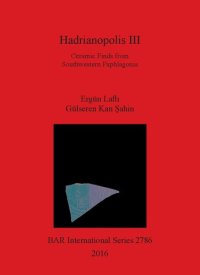
Ebook: Hadrianopolis III: Ceramic Finds from Southwestern Paphlagonia
Author: Ergün Laflı Gülseren Kan Şahin
- Series: BAR British Archaeological Reports International Series 2786
- Year: 2016
- Publisher: British Archaeological Reports Oxford Ltd
- Edition: Illustrated
- Language: English
- pdf
Pottery finds collected from Hadrianopolis in southwestern Paphlagonia (north-central Turkey), i.e. the region around Eskipazar in the Turkish province of Karabük are presented in detail in this volume. Between 2005 and 2008 an archaeological team from the Dokuz Eylül University in Izmir carried out archaeological field surveys, excavations and restorations in Hadrianopolis and its close surroundings. During these four field campaigns, 1550 sherds ranging between the Pre-Iron Age (2nd millennium BC) and the Middle Byzantine period (late 11th-early 12th century AD) were collected, most of which consist of Late Roman-Early Byzantine (late 5th-mid 8th century AD) coarse ware. Thirty main pottery groups were derived, based on their chronology,function and fabric. A detailed description is given of each find deposit, the typologies and fabrics of wares, and a comprehensive catalogue is included with drawings and photos of each sherd. This book is the first extensive pottery report of the Turkish Black Sea area offering a continual picture of all the wares and chronologies available. From the Foreword by Roger J. Matthews, University of Reading 23rd September 2015: It gives me great professional and personal pleasure to write a foreword to Hadrianopolis III, in which the ceramic materials from the Paphlagonian site of Hadrianopolis and its region are published in exemplary manner by Ergün Lafli and Gülseren Kan Sahin. The volume contains the fullest possible description and discussion of a wealth of ceramic material from the 2005-2008 field seasons in and around Hadrianopolis. I believe this volume can stand as a model of how to publish archaeological material in a manner of most benefit to colleagues with a wide range of professional interests... Through publication of this volume, the authors demonstrate the unique value in cherishing, recovering, analysing and, above all, fully publishing the material evidence recovered in systematic archaeological investigation. Present and future scholars owe them a considerable debt as well as sincere congratulations.